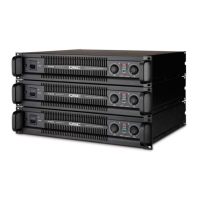48 QSC Audio Products, LLC
Figure 3.13. Output signal and positive rail steps.
Figure 3.14.
Output signal and negative rail steps.
Fault: Incorrect gain
• Channel 1: R23 and R31 set the gain of the output stage;
Channel 2: R147 and R153 set the gain of the output stage.
• The two gain control potentiometers are each buffered by a
single op-amp stage, whose gain is set by a pair of resistors.
Channel 1: R11 and R16.
Channel 2: R137 and R139. Make sure Q48 is turned on (with the
amplifier not in bridged mono mode). Grounding R137 at Q48
should not affect gain; if it does, check R132, which turns Q48 on
or off.
• Each channel’s balanced input is a differential op-amp stage. The
gain of each is set by four matched resistors R8, R9, R12, and
R13 on Channel 1 and R129, R130, R135, R136. Confirm both the
+ and - sides of the balanced inputs are working; check R5 and
R6 on channel 1 and R123 and R124 on channel 2.
Audio Power Stage: Troubleshooting Clipping
and Limiting
Fault: Excessive clip sticking (too much distortion
during clip limiting)
• Channel 1: C14 is much too large in value;
Channel 2: C49 is much too large in value;
(these can also cause increased high frequency distortion).
• Channel 1: R38 is missing or open;
Channel 2: R161 is missing or open.
• Channel 1: R38 or R39 are of wrong values;
Channel 2: R161 or R162 are of wrong values.
• Channel 1: Q9 or Q10 is missing or open;
Channel 2: Q54 or Q55 is missing or open.
• Channel 1: R34 or R35 is missing or open;
Channel 2: R157 or R158 is missing or open.
• Channel 1: Q8 is missing or open;
Channel 2: Q53 is missing or open.
Fault: Clip limiting doesn’t work (both channels)
• See if U3 is missing or defective.
• Check U3 supply voltages at +13VCL and -13VCL. You can find
node +13VCL at the junction of R246 and C73, and -13VCL at
R247 and C74.
Fault: Clip limiting doesn’t work (only one channel)
With your oscilloscope, probe the op-amp output on pin 7 of U2
(channel 1) or U7 (channel 2), while the channel is clipping. If the
signal peaks exceed 4 V during clipping, check these components:
• R38 (channel 1) or R161 (channel 2) may be missing or open.
• R38 or R39 (channel 1), or R161 or R162 (channel 2), may have
incorrect values.
• Q9 or Q10 (channel 1), or Q54 or Q55 (channel 2), may be missing
or open.
• R34 or R35 (channel 1), or R157 or R158 (channel 2) may be
missing or open.
• Q8 (channel 1), or Q53 (channel 2), may be missing or open.
If the op-amp output clamps at 3.5–4 V as expected, check these
parts surrounding U3:
• R32 (channel 1) or R154 (channel 2), may be missing or open.
3.2 PL325 and PL340: Symptoms, causes, and remedies (continued)

